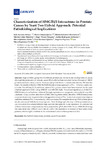Mostrar o rexistro simple do ítem
Characterization of HMGB1/2 Interactome in Prostate Cancer by Yeast Two Hybrid Approach: Potential Pathobiological Implications
| dc.contributor.author | Barreiro-Alonso, Aida | |
| dc.contributor.author | Cámara-Quílez, María | |
| dc.contributor.author | Salamini-Montemurri, Martín | |
| dc.contributor.author | Lamas, Mónica | |
| dc.contributor.author | Vizoso-Vázquez, Ángel | |
| dc.contributor.author | Rodríguez-Belmonte, Esther | |
| dc.contributor.author | Quindós-Varela, María | |
| dc.contributor.author | Martínez-Iglesias, Olaia | |
| dc.contributor.author | Figueroa, Angélica | |
| dc.contributor.author | Cerdán, María Esperanza | |
| dc.date.accessioned | 2019-11-29T12:10:51Z | |
| dc.date.available | 2019-11-29T12:10:51Z | |
| dc.date.issued | 2019-11-05 | |
| dc.identifier.citation | Barreiro-Alonso, A.; Cámara-Quílez, M.; Salamini-Montemurri, M.; Lamas-Maceiras, M.; Vizoso-Vázquez, Á.; Rodríguez-Belmonte, E.; Quindós-Varela, M.; Martínez-Iglesias, O.; Figueroa, A.; Cerdán, M.-E. Characterization of HMGB1/2 Interactome in Prostate Cancer by Yeast Two Hybrid Approach: Potential Pathobiological Implications. Cancers 2019, 11, 1729. | es_ES |
| dc.identifier.issn | 2072-6694 | |
| dc.identifier.uri | http://hdl.handle.net/2183/24409 | |
| dc.description.abstract | [Abstract] High mobility group box B (HMGB) proteins are pivotal in the development of cancer. Although the proteomics of prostate cancer (PCa) cells has been reported, the involvement of HMGB proteins and their interactome in PCa is an unexplored field of considerable interest. We describe herein the results of the first HMGB1/HMGB2 interactome approach to PCa. Libraries constructed from the PCa cell line, PC-3, and from patients’ PCa primary tumor have been screened by the yeast 2-hybrid approach (Y2H) using HMGB1 and HMGB2 baits. Functional significance of this PCa HMGB interactome has been validated through expression and prognosis data available on public databases. Copy number alterations (CNA) affecting these newly described HMGB interactome components are more frequent in the most aggressive forms of PCa: those of neuroendocrine origin or castration-resistant PCa. Concordantly, adenocarcinoma PCa samples showing CNA in these genes are also associated with the worse prognosis. These findings open the way to their potential use as discriminatory biomarkers between high and low risk patients. Gene expression of a selected set of these interactome components has been analyzed by qPCR after HMGB1 and HMGB2 silencing. The data show that HMGB1 and HMGB2 control the expression of several of their interactome partners, which might contribute to the orchestrated action of these proteins in PCa. | es_ES |
| dc.description.sponsorship | Instituto de Salud Carlos III; PI14/01031 | es_ES |
| dc.description.sponsorship | Xunta de Galicia; ED431C 2016-012 | es_ES |
| dc.language.iso | eng | es_ES |
| dc.publisher | MDPI | es_ES |
| dc.relation.uri | https://doi.org/10.3390/cancers11111729 | es_ES |
| dc.rights | Atribución 4.0 Internacional | es_ES |
| dc.rights.uri | http://creativecommons.org/licenses/by/4.0/ | * |
| dc.subject | Two hybrid | es_ES |
| dc.subject | Interactome | es_ES |
| dc.subject | Prostate cancer | es_ES |
| dc.subject | Biomarker | es_ES |
| dc.title | Characterization of HMGB1/2 Interactome in Prostate Cancer by Yeast Two Hybrid Approach: Potential Pathobiological Implications | es_ES |
| dc.type | info:eu-repo/semantics/article | es_ES |
| dc.rights.access | info:eu-repo/semantics/openAccess | es_ES |
| UDC.journalTitle | Cancers | es_ES |
| UDC.volume | 11 | es_ES |
| UDC.issue | 11 | es_ES |
| UDC.startPage | 1729 | es_ES |
Ficheiros no ítem
Este ítem aparece na(s) seguinte(s) colección(s)
-
GI-EXPRELA - Artigos [28]






